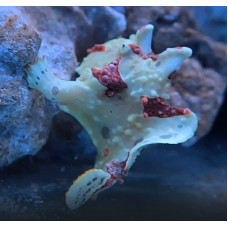Latin name
Antennarius maculatus
Other name
Clown frogfish
Identification
Antennarius maculatus has the generic name Antennarius, with the suffix -ius meaning "antenna", alluding to the fact that the first dorsal outgrowth was adapted as a tentacle on the snout, used as a lure to attract prey. The species name maculatus means "spotted", alluding to the many round brown spots of varying sizes on the body.
Like other members of this family, warty frogfish have a spherical, expandable body and their soft skin is covered with dermal spines. These are made up of many small wart-like growths.
Features of fish fins
Dorsal spines (total): 3; Dorsal soft rays (total): 11 - 12; Anal spines: 0; Anal soft rays: 6 - 7.
The first dorsal spur, illicium, is modified and used as a fishing rod. Its tip is equipped with a characteristic esca (bait) that looks like a small fish of pinkish-brown color. The illicium is twice as long as the second dorsal spine and often has dark stripes. The second dorsal spine is almost straight and flexible, while the third is curved toward the back of the body. They are attached to the head by webbing and are well separated from each other and from the dorsal fin.
The pectoral fins are angled and, together with the pelvic fins, help the fish move along the bottom and maintain a stable position for ambush.
Fish colouring
The body coloration of warty frogfish is extremely variable and usually corresponds to the habitat conditions. They are capable of changing coloration and pigment structure over a period of weeks: during coral bleaching, they may even become simply white to blend in with their surroundings. However, the dominant coloration varies from white to black, through a range of related shades such as cream, pink, yellow, red and brown, often with dark round spots and/or saddles.
Some heavily spotted individuals can easily be confused with their close relative Antennarius pictus. This feature can help distinguish them: A. maculatus usually has red or orange margins on all fins, and sometimes a saddle-spotted tip begins behind the eye.
Distribution
Widespread in tropical Indo-Pacific waters from Mauritius and Reunion Island in the central Indian Ocean to the western Pacific.
Habitat
A marine tropical species. Occupies sheltered rocky and coral reefs. Depth from 1 to 15 meters.
Size
Warty frogfish grow up to 15 centimeters (5.9 inches) in length.
Behavior
Warty frogfish are bottom dwelling and solitary. This species is biofluorescent, meaning that when illuminated with blue or ultraviolet light, it emits red light and looks different from white light. Biofluorescence may aid in intraspecific communication and camouflage.
Food and feeding habits
It is a voracious carnivore, capable of attacking any small animal within its "reach", mainly fish. Its prey can vary in size, approaching its own size. The warty frogfish's large protruding mouth allows it to consume larger food items. Adults typically feed on sponges at depths of up to 20 m (66 ft).
Reproduction
Laying eggs. The eggs are encased in a ribbon-like sheath or mass of gelatinous mucus called an "egg raft" or "veil". They come together during the mating season, but after fertilization they no longer tolerate each other. The female may kill or eat the male if he remains in the vicinity.
Fishing
The species is of no commercial interest in the fishery.
Relationship with a person
Harmless. Warty frogfish can be found in the aquarium trade.
| Classification | |
| Phylum | Chordata |
| Class | Actinopterygii |
| Squad | Lophiiformes |
| Family | Antennariidae |
| Genus | Antennarius |
| Species | A. maculatus |
| Features | |
| Conservation status | Least Concern |
| Habitat | Pelagic |
| Life span, years | No information |
| Maximum body weight, kg | No information |
| Maximum length, cm | 15 |
| Sailing speed, m/s | No information |
| Threat to people | Not edible |
| Way of eating | Predator |
Warty frogfish
Tags: warty frogfish

